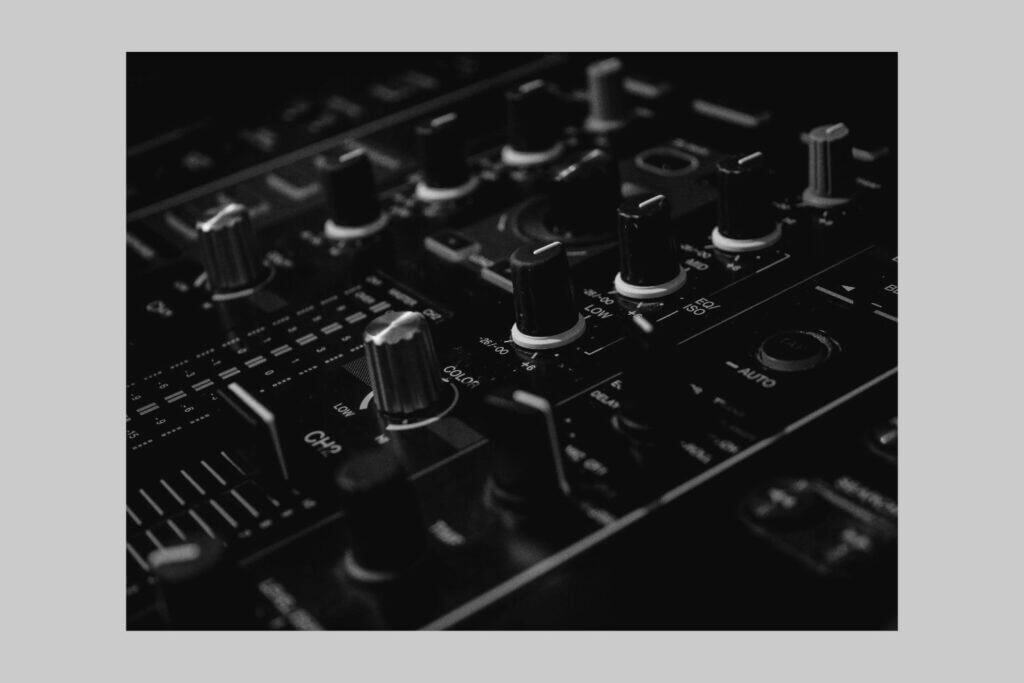Why Do DJs Turn Knobs? Or appear to be turning knobs! Well, that can be a well-debated question but let’s tackle it head-on!
If you’re someone that has only just started looking into DJing, DJ tips, and what it takes to be a DJ, one of the things you may be curious about is what they’re often doing when performing; particularly when playing with the different knobs and dials on their DJ mixer.
While most people on the dance floor expect to see DJs doing a bit of scratching with the records/platters, the rest of their controllers and mixers can be a bit of a mystery.
In truth, there are a lot of different things a DJ could be doing while operating the DJ mixer.
Often times they could be turning knobs to adjust a track’s volume, while other times it could be working the EQ or ensuring an incoming track can blend in during its transition.
DJs can also use these knobs as a precursor before bringing in different added effects (via the controller’s FX controls) or setting up a hot cue.
The good news is that, with rare exceptions, virtually all quality DJ controllers and mixers will have a few of these different EQ and frequency knobs that you can play with. In this overview, we’ll spend some time breaking down what these different knobs do to the sound system levels while also going over some of the other things you’ll see a DJ operating while they’re on stage.
Why Do Djs Turn Knobs? (in short!)
DJs turn knobs on their equipment to adjust various settings and parameters, such as volume, equalization, and effects. These adjustments allow them to manipulate the sound in real time, creating unique and dynamic mixes that engage the audience and keep them dancing. Knob-turning is an essential skill for DJs, as it allows them to control the energy and mood of their set, adapting to the crowd and creating a personalized experience for each performance.
Additionally, turning knobs can be a visual and tactile expression of the DJ’s artistry, adding to the performance and creating a sense of excitement and anticipation for the audience.

Read this next: Using EQs on a DJ Mixer (Nailing This Vital DJ Skill)
Why DJs Turn Knobs? The Science
Essentially what DJs are doing, when twisting different knobs, is working to synchronize the DJ mix sounds and beats of two different songs with one another. In other words, they’re equalizing.
Generally, even if you’re using two songs from the same genre, there’s going to have to be some work on your end to get their beats to properly match up with one another. Some of that work includes making sure their sounds are balanced to ensure neither is overloading the other.
Even if you’re a DJ that tends to use the sync button on some controllers and mixers to DJ mix, or you’re apt to use some of the different DJ software options available, electronic music mixing can still require a bit more effort on your end.
As an example, the outro for one song must ideally have its beat be in-line with the intro of the following track. To do that, you’re going to have to properly juggle two basslines, mid-ranges, and high-end sound frequencies at the same time. Doing this without proper equalization can lead to some serious issues (such as a blown-out set of speakers).
Mix Equalizing
So, when working with the EQ of any track, a DJ will utilize knobs for a track’s high-end frequency, its mid-level frequency, and its bassline frequency. Each of these three frequency ranges carries with it its own respective sound pitch that is recognized when listened to.
As an example, the bass of a track can range between 60 and 250 Hz while mid-range frequencies will vary between 500 Hz and 2kHz. When it comes to high-range frequencies, these often will flit between 2kHz and 4kHz.
Low-End Bass Frequencies
As a track initially comes in, you’ll have to cut the bass of one entirely to ensure the low-end frequency range isn’t overloaded and causing a massive low-end bass sound explosion (which, again, would wreck your speakers and any nearby eardrums).
Even at less intense levels, too many low-end frequencies can “muddy” the sound, effectively making everything harder to properly hear.
Mid-Range Frequencies
On the other end of the spectrum, mid-level sounds tend to be where most instruments sit at. These include the piano, the guitar, most percussion instruments, as well as the majority of vocals.
These instruments can certainly always “sink” lower or “raise” themselves higher, but generally, they will tend to sit in the mid-range frequencies and are the baseline for the majority of songs and music. Often these don’t run the same risk of getting muddied as bass tracks, though you’ll still want to be aware of them when dealing with it along with the other ranges.
High-End Frequencies
Lastly, the higher-end frequencies are meant to be the “pings” and tiny sounds, often only meant when an instrument is intentionally putting itself at those higher levels. As with an overloaded bass, too many sound frequencies in the high range can be seriously unpleasant to your audience, even if they won’t necessarily destroy your speakers.
By properly utilizing the different knobs and dials on your mixer, you can adjust the tracks and their respective sound frequency levels so that they can not only keep from competing with one another but also act as effective transitions from one track to the other.

Read this next: Using DJ Sound Effects Properly (The Top 5 FX)
FX Knobs Explained
Since we’ve addressed the most important EQ knobs already, many would expect that there wouldn’t be anything left to talk about. The truth is that, while manipulating a track’s EQ levels is vitally important to master, these knobs and dials aren’t all that’s on a mixer.
In addition, there are also a plethora of different effect knobs which act as a complement to the EQ controls while helping bring color to a DJ’s performance.
For most DJ mixers, the FX knobs can also be FX buttons. When used as a knob, however, there can be an adjustable intensity to the effects, with harder twists having a more pronounced impact than smaller twists.
This is why you’ll many DJs dramatically “crank” their arms all the way when turning knobs on an FX dial. Some of the more commonly used FX options include a high-pass filter, a low-pass filter, as well as reverb, echo, and flanger.
High-Pass Filter
The high-pass filter effect allows DJs to essentially cut out low-end frequencies while allowing higher-end frequencies the ability to easily pass through and be heard. This is great for helping transition a track in or out based on its higher-end frequency.
Low-Pass Filter
Low-pass filters act similarly to high-pass filters with the difference being that low-pass filters allow low-end frequencies to pass through while cutting out high-end frequencies. As with the high-pass filter, it’s great for transitioning from one track to another, especially if the newer track has a more impressive bass line that you want to really emphasize.
Reverb/Echo/Flanger
Some of the other effects that DJs often use include the reverb, echo, and flanger options. Whereas the two filter options focus on cutting either the low or high-end frequencies out, these other options instead on infusing tracks with some new energy without performing a ton of extra steps.
Tapping Vs. Pressing Cue Buttons
When it comes to the tapping vs. pressing debate, DJs can indeed do both depending on the situation. Generally, however, you’ll find that DJs more often than not use the “tapping” method when hitting certain buttons like the main cue button.
This is so that they can effectively keep in line with the song’s beat as well as prime themselves for the next track. They can even increase the volume fader during the process, adding an extra beat into a section of one song that is already playing.
Tapping can also be used to set up hot cues when getting ready to do acapella as well as one-shots.
Tapping is an incredibly useful technique as you can keep pace with the beat and ensure everything is in just the right order when cueing up or using an effect.
Button-pressing, on the other hand, is a bit different and not quite as useful in comparison. Generally, the difference is that pressing a button is meant for very specific effects that work so long as the button is directly pressed. These often include some looping effects. Still, this is often only done on certain DJ controllers and mixers and only for those specific instances.
Interestingly, there are some DJs that will press buttons and twist knobs solely to look busy. More often than not, these buttons, dials, and knobs aren’t actually in play and won’t affect the music in any way.
It’s not to say that these buttons and knobs are on the mixer for show. Instead, it would be like pressing buttons on a tv remote while the tv itself is off or set to HDMI instead of the network stations.

Read this next: Crossfader vs Channel Fader (The Great Debate)
FAQs
Why Are Some DJs So OVER THE TOP When Performing?
Well, this is based on the DJ. There is a bit of it that comes down to musical style or the DJ persona, but more often than not, it’s just small things a DJ may do to get their crowd interested in what they’ve got going on.
Are DJ Software Knobs The Same As Mixer Knobs?
This generally depends on the type of DJ software you’re using. For the leading brands out there (Serato DJ, Rekordbox, Virtual DJ, and Traktor Scratch Pro) they’ve worked to make the layout as exact as what a physical mixer would be like, with many of the buttons, dials, and knobs functioning the same.
Are EQs & FXs Required To Be A Good DJ?
Not at all! While mastering your EQ levels is important for overall sound quality, the different effects available are only meant as tools you can use during your performance. There are some DJs that use a ton and there are some DJs that use very little. So long as your audience is enjoying themselves, you’re pretty much good to go.
You won’t have the tactile sensation of physically turning a knob or pressing a button, no, but the actual effect should be pretty identical. Again, it’s important to make sure your DJ software has that. While the leading options do, the same is not always the case for the newer software choices out there.

Read this next: What Are Channels On A DJ Mixer? (A Quick Intro to DJ Channels)
Why Do DJs Turn Knobs? The Verdict
So why do DJs turn knobs? Have we clarified turning knobs for you? DJ controllers and DJ mixer knobs, while they may seem like strange or complex inclusions are hardly either. After playing with either device for a while, you’ll easily be able to pick up what does what and why it’s included.
Once you’ve spent a few trial performances playing with your controller, you’ll be able to know in your DJ mixes when to use the reverb or echo knobs and when to focus solely on the EQ knobs.
I can say that once you do have a solid understanding of these different controls, your ability to perform will improve dramatically.
Whether that’s simply keeping your sounds from competing with one another, setting up a smooth transition, or keeping the beat matched for some really cool tricks, understanding the different knobs on your device is one of the first steps you’ll have to take on your road to becoming a professional DJ.




